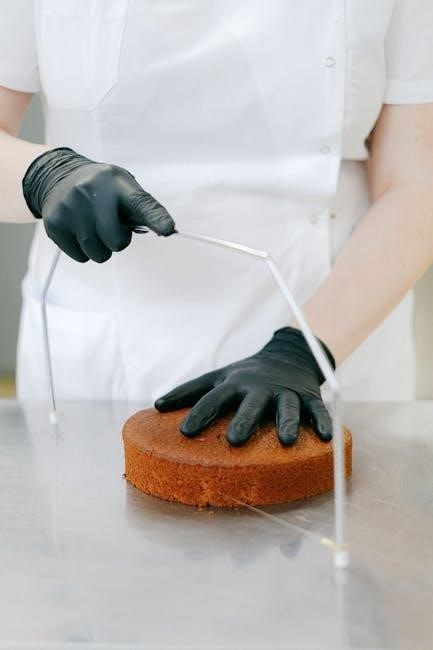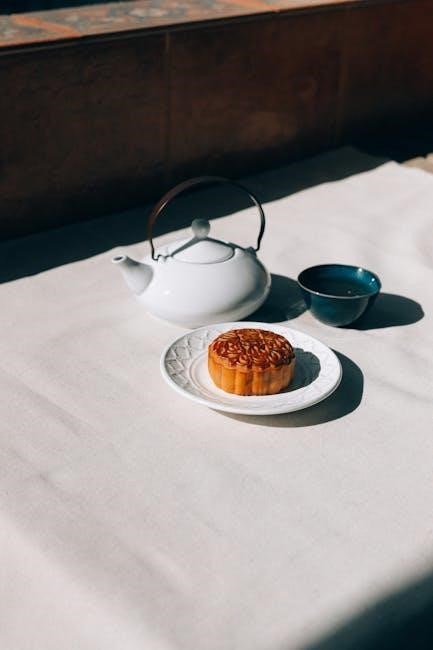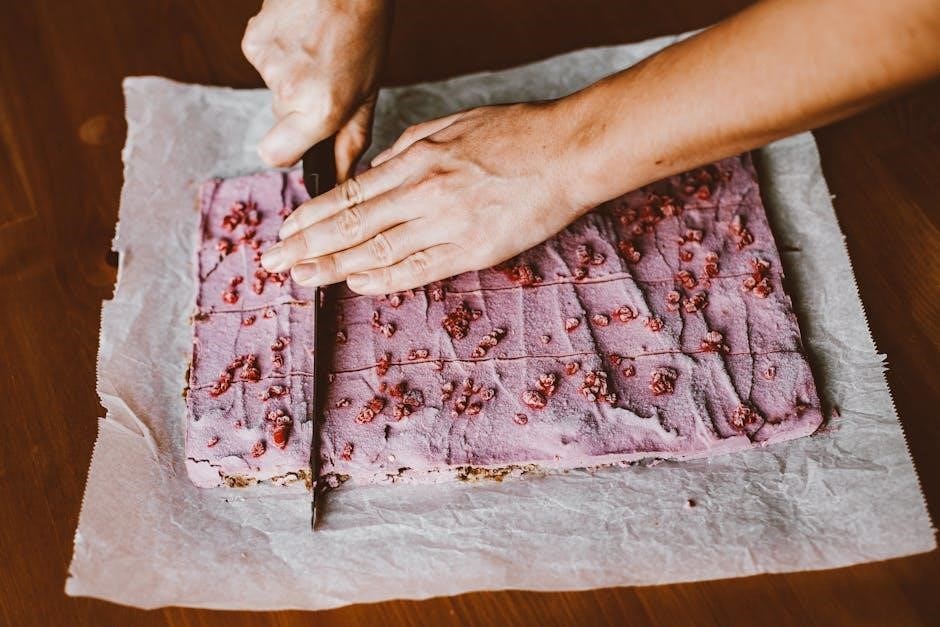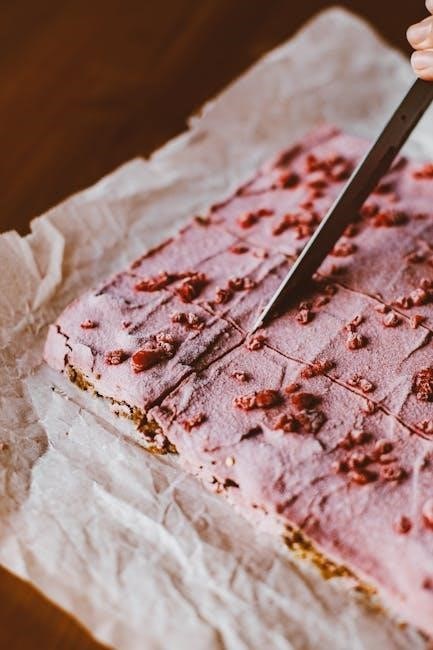Cake cutting is an art and essential skill for any baker or host. Proper techniques ensure precision, care, and presentation, making every slice memorable and enjoyable for all.
1.1 Importance of Proper Cake Cutting Techniques
Proper cake cutting techniques are crucial for achieving clean, even slices and preserving the cake’s appearance. They ensure consistency in portion sizes, prevent waste, and enhance the overall presentation. Sharp tools and precise movements are key to maintaining the cake’s structural integrity. Mastering these techniques also elevates the dining experience, making every slice look appealing and professional. It’s a skill that combines artistry with practicality, ensuring satisfaction for all who indulge.
1.2 Brief Overview of Round Cakes
Round cakes are a classic choice for celebrations, offering uniformity in texture and appearance. Their circular shape allows for even layering and frosting, making them ideal for decorative designs. Typically baked in round pans, these cakes are versatile, serving as a base for various flavors and toppings. Their symmetry ensures consistent slicing, while their structure supports multi-tiered presentations, making them a popular choice for weddings, birthdays, and special occasions.

Tools and Equipment Needed
A serrated knife, cake turner, and serving plate are essentials. Optional tools include a wire cutter for precise cuts and a stand for stability while slicing.
2.1 Essential Tools for Cutting Round Cakes
A sharp serrated knife is a must-have for clean, precise cuts. A cake stand or turntable allows easy access to all sides. A serving spatula or tongs helps portion slices neatly. Optional but useful tools include a wire cutter for even layers and a damp cloth to wipe the knife between cuts, ensuring smooth slicing.
2.2 Optional Equipment for Precise Cutting
For enhanced precision, consider using a cake leveler to ensure even layers or a serrated knife with a long, straight edge for smooth cuts. Parchment paper can prevent crumbs from spreading, while a cake turntable allows easy access to all sides. A measuring guide or cake marker helps divide the cake evenly, ensuring uniform portions and professional results.
Preparing the Cake for Cutting
Ensure the cake is level, crumb-free, and chilled for clean slices. Leveling prevents wobbling, while chilling firms the texture, making cutting precise and mess-free.
3.1 Leveling the Cake for Even Slicing
Leveling ensures even slicing and a stable base. Place the cake on a flat surface, use a serrated knife or cake leveler to trim the dome. Start from the center, sawing gently in a straight line. Rotate the cake as you go for an even cut. Excess frosting or crumbs can be removed with a damp cloth. Chilling the cake beforehand firms the texture, making leveling easier and more precise.
3.2 Removing Crumbs and Excess Frosting
After leveling, gently sweep crumbs with a soft brush or damp cloth. Excess frosting can be removed with a flat spatula or knife. Rotate the cake, ensuring all sides are clean. For stubborn crumbs, lightly press with a paper towel. A clean cake prevents crumbs from mixing with frosting and ensures a professional look. Chilling the cake first can help firm the frosting, making cleanup easier and more efficient. This step is crucial before slicing for even portions and better presentation.
3.3 Chilling the Cake for Easier Cutting
Chilling the cake in the refrigerator for about 30 minutes firms the layers and frosting, making it easier to slice cleanly. This step prevents crumbling and ensures even portions. For best results, avoid over-chilling, as it can make the cake too hard. Lightly wipe the knife with a damp cloth between cuts to maintain smooth, precise slices. Chilling is especially helpful for cakes with soft or delicate frosting.

Basic Cake Cutting Techniques
Start by placing the cake on a turntable or serving plate. Use a serrated knife to make smooth, even cuts from the center outward for uniform slices.
4.1 General Tips for Cutting Round Cakes
Use a serrated knife for smooth cuts and warm the blade with water for easier slicing. Place the cake on a turntable for better access. Freeze the cake for 10 minutes to firm it up, making cutting cleaner. Start from the center and cut outward in even strokes. Ensure the knife is hot for each cut to prevent crumbs. Serve slices immediately for freshness and presentation.
4.2 Using a Cake Turner or Serving Plate
A cake turner or serving plate enhances presentation and accessibility. Place the cake on a sturdy, flat surface or turntable. Use a hot knife for clean cuts, slicing from the center outward. Rotate the cake as you cut to maintain even access. Transfer slices to plates using a spatula for neat serving. This method ensures precision and makes serving efficient, especially for large gatherings or special occasions.
Advanced Cutting Methods
Advanced techniques involve precision tools like serrated knives or wire cutters for clean cuts. Pro tip: warm the knife in water for effortless slicing through dense layers.
5.1 The “Wire Cutter” Method
The wire cutter method ensures smooth, even cuts. A taut wire glides through the cake effortlessly, minimizing crumbs and providing uniform slices. Ideal for layered or frosted cakes, this technique prevents tearing and keeps the cake intact. For best results, lightly chill the cake to firm the layers before cutting. This method is perfect for achieving professional-looking portions.
5.2 The “Serrated Knife” Technique
The serrated knife technique is a popular method for cutting round cakes. Use a long, sharp serrated knife to saw gently through the cake in smooth, even strokes. This method minimizes crumbs and ensures clean cuts. For best results, warm the knife slightly by running it under hot water and drying it before cutting. This technique works well for both frosted and unfrosted cakes, providing precise control over portion sizes.
Portion Control and Size
Portion control ensures consistent and fair serving sizes, enhancing both presentation and guest satisfaction. Proper sizing is key to achieving uniform slices and balanced flavors in round cakes.
6.1 Standard Portion Sizes for Round Cakes
Standard portion sizes for round cakes typically range from 1.5 to 2 inches in width per slice; This ensures each guest receives a generous yet manageable serving. For an 8-inch cake, 8-10 slices are ideal, while a 10-inch cake yields 10-12 slices. Consistent sizing maintains visual appeal and prevents waste, making it easier to serve evenly at gatherings or events.
6.2 Ensuring Even and Consistent Portions
To achieve even and consistent portions, use a serrated knife and guide it with a cake leveler or measuring tool. Rotate the cake stand as you cut to maintain uniformity. Mark the cake with evenly spaced toothpicks for reference. Slice slowly and apply gentle pressure, ensuring each cut aligns with the previous one. Chilling the cake briefly can also help produce clean, precise cuts for professional-looking results.

Cutting Frozen or Thawed Cakes
Cutting frozen or thawed cakes requires precision and care. Use a warm knife for smooth cuts, and thaw frozen cakes evenly to ensure clean, even slices.
7.1 Thawing Tips for Frozen Cakes
Thawing frozen cakes requires patience and care. Place the cake on a stable surface at room temperature or in the refrigerator overnight for even thawing. Avoid direct heat to prevent sogginess. Use a warm knife for smooth cutting, ensuring the blade glides effortlessly through the thawed layers. For partial thawing, let the cake sit at room temperature for 30 minutes. Always wrap tightly if refreezing to maintain freshness and texture;
7.2 Best Practices for Cutting Frozen Cakes
A pro tip for cutting frozen cakes is to dip your knife in warm water and wipe it clean before each slice. Use a serrated knife for smooth cuts, applying gentle pressure to avoid crumbling. Let the cake sit for 10-15 minutes to soften slightly, then cut on a stable surface. For even portions, mark the cake with a toothpick or skewer before slicing.
Serving and Presentation
Use dessert plates and serving utensils for an elegant presentation. Garnish slices with fresh flowers or berries for visual appeal, ensuring each portion looks inviting and well-prepared.
8.1 Using Dessert Plates and Serving Utensils
Use high-quality dessert plates and serving utensils to enhance presentation. Ensure plates are large enough to accommodate slices comfortably. Select flatware that complements the cake’s design, such as stainless steel or gold-plated servers. Always warm the knife before cutting to create clean, even slices. This attention to detail elevates the dining experience, making each portion visually appealing and professionally served.
8.2 Garnishing Slices for Enhanced Appeal
Garnishing cake slices adds a finishing touch that delights the eyes and taste buds. Fresh fruits like strawberries or blueberries, edible flowers, or chocolate shavings are popular choices. Dust lightly with powdered sugar or cocoa for a elegant look. Place a single berry or sprinkle on each slice for a personal touch. Ensure garnishes complement the cake’s flavor and theme, enhancing both presentation and taste effortlessly.
Safety Considerations
Always handle sharp knives and tools with care. Use oven mitts to protect hands from hot surfaces. Keep children away from sharp objects and cutting areas to prevent accidents.
9.1 Handling Sharp Objects Safely
When cutting a cake, always handle sharp knives and tools with extreme care. Ensure the knife is dry to avoid slipping. Store sharp objects out of children’s reach. Use a stable cutting surface and maintain focus to prevent accidents. Dull knives are more dangerous than sharp ones, so keep blades well-maintained. Always cut away from your body for added safety.
9.2 Preventing Accidents in the Kitchen
To ensure a safe cake-cutting experience, always clear the workspace of clutter. Use oven mitts or towels to handle hot equipment. Keep sharp tools out of children’s reach and store them properly. Avoid distractions while cutting, and supervise children nearby. Regularly inspect knives for damage and maintain a clean, dry environment to prevent slips. These precautions help create a secure and enjoyable kitchen experience.
Handling Leftovers
Store uneaten cake in an airtight container to maintain freshness. Refrigerate for up to 5 days or freeze for longer preservation. Always thaw frozen slices properly before serving.
10.1 Storing Uneaten Cake Properly
To maintain freshness, store uneaten cake in an airtight container. Place it in the refrigerator for up to 5 days or freeze for longer preservation. For freezing, wrap the cake tightly in plastic wrap or aluminum foil. When ready to serve, thaw frozen slices in the refrigerator or at room temperature. Proper storage prevents drying out and keeps the cake flavorful and moist.
10.2 Freezing and Reheating Instructions
For long-term preservation, freeze the cake by wrapping it tightly in plastic wrap or aluminum foil. Store in a freezer-safe bag to prevent freezer burn. To reheat, thaw frozen slices in the refrigerator overnight or at room temperature for a few hours. For quicker reheating, microwave slices with a damp paper towel for 10-15 seconds to restore moisture and freshness without overcooking.

Decorative Cutting Techniques
Enhance your cake’s visual appeal with decorative cuts. Use a sharp knife to create patterns, such as stripes or swirls, and add intricate designs for a professional finish.
11.1 Creating Patterns with the Knife
Transform your cake into a masterpiece by crafting intricate patterns. Use a serrated knife to make precise, even cuts, creating designs like stripes, swirls, or geometric shapes. Start with light pressure to guide your cuts, then deepen as needed. For symmetry, mark the cake’s center with a toothpick and work outward. Experiment with vertical, horizontal, or diagonal strokes to add texture and visual interest; Practice on plain sheets first to refine your technique.
11.2 Adding Visual Appeal to Slices
Elevate the presentation of your cake slices by adding fresh berries, chocolate shavings, or edible flowers. A drizzle of glaze or sauce can create a stunning visual effect. Ensure consistent portion sizes and arrange slices symmetrically on a serving plate. Balance flavors with textures, like smooth frosting and crunchy toppings, to enhance both taste and appearance. Every slice should look as inviting as it tastes, making the experience delightful for everyone.

Common Mistakes to Avoid
Avoid overcrowding the cake plate and cutting too quickly. Ensure smooth, steady slices by using proper tools and maintaining patience for a clean, professional finish.
12.1 Overcrowding the Cake Plate
Overcrowding the cake plate can lead to uneven slices and a messy presentation. Arrange slices neatly, ensuring space between each piece for a clean, visually appealing display. This prevents crumbs and frosting from smudging neighboring portions. A cluttered plate can also make serving difficult, so prioritize organization for both aesthetics and convenience. A well-spaced arrangement enhances the overall appeal of your perfectly cut cake.
12.2 Cutting Too Quickly or Aggressively
Cutting too quickly or aggressively can damage the cake structure, causing uneven slices or crumbling. A serrated knife and gentle, smooth strokes are essential for clean cuts. Apply steady pressure without rushing to maintain control. Avoid applying too much force, as this can squash the cake or smudge frosting. Patience ensures precise, even portions and a professional finish every time.
Mastering cake cutting requires patience, proper tools, and technique. With practice, you’ll achieve clean, even slices, ensuring every serving is both beautiful and delicious.
13.1 Summary of Key Points
Proper cake cutting involves essential tools like serrated knives and turntables. Techniques include leveling, chilling, and using wire cutters for precision. Safety, portion control, and presentation are crucial. Always use sharp tools, avoid overcrowding plates, and store leftovers properly. With practice, you’ll master even slicing and enhance the appeal of your round cakes, ensuring a delightful experience for everyone.
13.2 Final Tips for Perfect Cake Cutting
- Always chill the cake before cutting to ensure clean slices.
- Use a heated knife for smooth cuts, especially for frozen cakes.
- Place the cake on a turntable for even slicing.
- Opt for a serrated knife to avoid crumbling.
- Work patiently, allowing each slice to cool slightly.
- Garnish slices for a polished presentation.
- Store leftovers in an airtight container for freshness.
